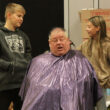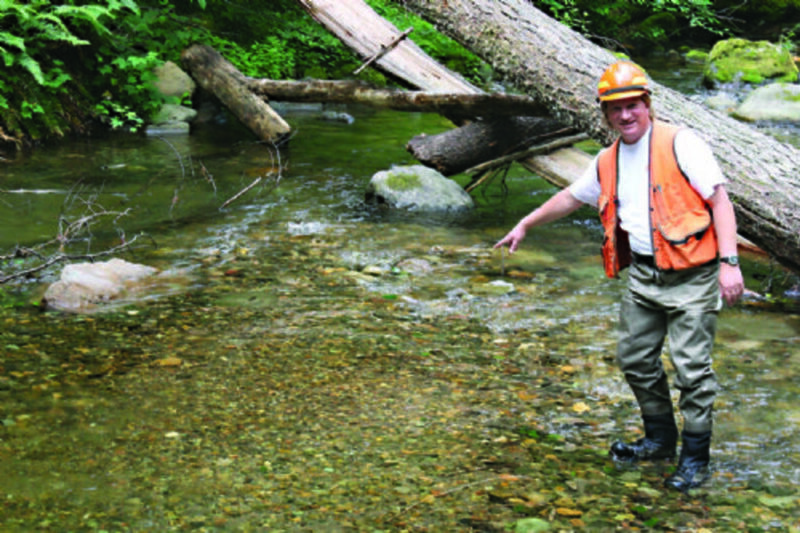Sean C. Morgan
A year ago, U.S. Forest Service and South Santiam Watershed Council officials were watching a contractor drop tall trees into the South Fork of the South Santiam River in an effort to improve the stream’s habitability for spawning spring Chinook salmon and winter steelhead.
They had no idea how long it would take to see the results they were looking for: fish creating “redds,” gravel beds in which the laid their eggs.
As it turns out, the results were quick in arriving. Forestry and wildlife officials are “ecstatic” this summer to discover that winter steelhead are spawning there after gravel accumulated behind the trees they toppled into the stream, covering the bare bedrock that has served as riverbed.
The harvest of fallen timber caused the stream to scour out gravel decades ago. Efforts to restore the river in the 1990s didn’t work well. Logs chained to the river bed failed to remain in place across the stream and failed to collect the gravel that helps provide spawning and rearing habitat.
In August 2013, the South Santiam Watershed Council, in cooperation with the U.S. Forest Service, dropped 34 trees, ranging from 28 to 44 inches in diameter, across nearly a mile of the Soda Fork of the South Santiam River, their root wads anchoring them to shore, their tops tangled with other trees toppled across the stream, to start catching and holding gravel in the stream – among the first steps in the Cool Soda Planning Area project.
The Cool Soda project is a result of the Sweet Home All-Lands Collaborative, a partnership between Cascade Timber Consulting, the Forest Service and the Watershed Council that began in 2012 and has become a springboard for other efforts to connect Sweet Home residents and visitors, economically and recreationally, with the forests to the east.
The $52,000 project is funded by an Oregon Watershed Enhancement Board grant with donations of trees and staff time from the Sweet Home Ranger District.
The river could also provide spawning beds for spring Chinook salmon and cutthroat trout, although the salmon tend to stay in the main stem or in the mouths of the tributaries.
“Basically what we’re seeing in the upstream structure there is a lot of gravel that has accumulated,” said SSWC Coordinator Eric Hartstein. “I can’t believe how much it’s accumulated.”
The Soda Fork experienced some storm events over the winter, Hartstein said. “But it certainly wasn’t anything out of the ordinary.”
In the accumulated gravel are two steelhead spawning nests, redds, Hartstein said. A third redd is above the project area.
On May 23, he went up and saw the amazing accumulation of gravel, he said. “The cherry on top – Soon after, the redds were found. I’m ecstatic.”
“I don’t think I’ve ever seen a project that responded that quickly to a restoration effort,” said Sweet Home Ranger District Hydrologist Lance Gatchell. “And then to have the fish go upstream and find it, it’s awesome. It definitely shows project success right off the bat.”
There has been nothing to indicate winter steelhead have spawned in the stream in the past decade, Harstein said. “We haven’t seen much of anything recently.”
Most likely, before the stream scoured the riverbed of gravel, winter steelhead spawned there, Hartstein said.
He really didn’t expect this fast of a response, he said. “Typically, when we’re doing this, we’re thinking of long term. It takes time for nature to respond.”
To have steelhead spawning the first year after the project, it shows it was a good, successful project, Hartstein said.
Gatchell said he and Hartstein had talked about taking adults to the Soda Fork in hopes they might spawn. They also talked about taking juveniles upstream instead to imprint the location prior to their migration downstream.
“We didn’t have to do that,” Gatchell said. “It’s amazing.”
Hartstein is unsure how many redds the stream will typically support, he said. It depends on the steelhead population. Right now, 200 to 400 adults return to the South Santiam annually. About 1,500 to 1,800 spring Chinook return.
The numbers over the Willamette Falls have been declining, and that has impacted South Santiam populations, Hartstein said. “This year, 214 winter steelhead were passed over Foster Dam, so a good portion of the steelhead that come into the South Santiam are presently spawning in tributaries of the South Santiam River below the dam.
“The South Santiam Watershed Council is doing a lot of work in these tributaries as well, but there is a huge potential in the upper South Santiam tributaries – Soda Fork, Canyon Creek and Moose Creek – to enhance habitat conditions, particularly now that fish collection facilities have improved at Foster Dam.
“Hopefully, what we will see is that not only numbers will improve at Foster Dam but across the South Santiam watershed and by extension the entire upper Willamette Basin as well,” Hartstein said.
He said a lot of the credit must go to Gatchell, who completed the design work for the project.
Without Gatchell’s contributions, the project would not be successful, Hartstein said. Soda Fork has a lot of power, and plans needed a lot of thought to keep trees from being blown downstream.
Redds are also showing up in Canyon Creek, where the Forest Service and Watershed Council have been working the past couple of years as well.
In that river, trees were cut to 80 feet and dropped into the stream by helicopter to create meanders on the outside bends and island jams.
The goal there was to create deeper pools to provide better rearing habitat, Hartstein said. The gravel was already there, but the stream was wide and shallow, which caused problems for rearing fish.
In Soda Fork, the Sweet Home Ranger District is replacing undersized culverts, which have been preventing gravel from washing downstream into the river, Hartstein said. That should provide an additional boost to the gains already in place.





